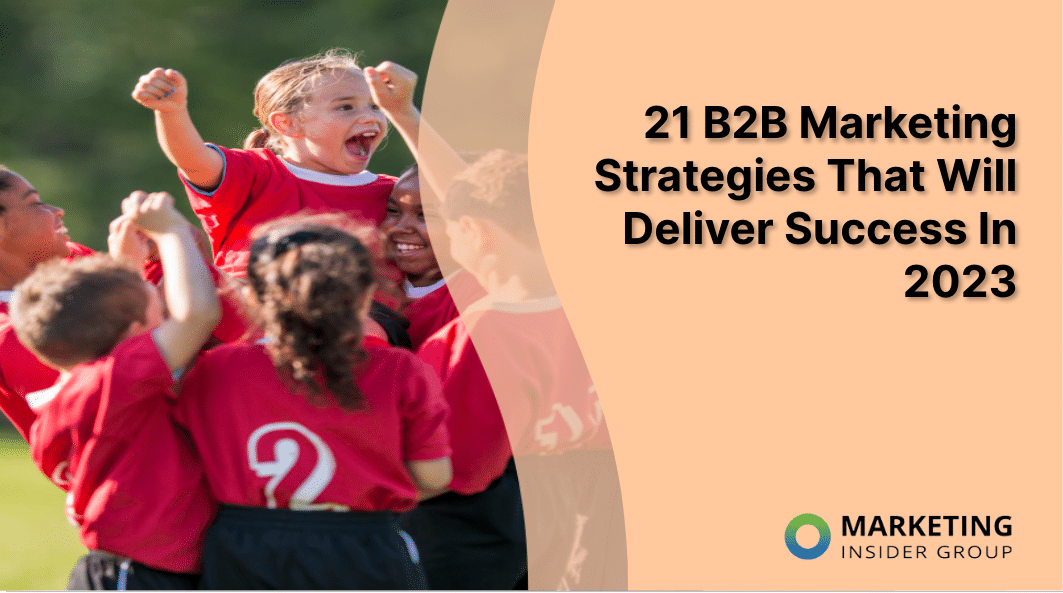
27 B2B Marketing Strategies That Will Deliver Success in 2024
“Strategy without tactics is a daydream; tactics without strategy is a nightmare.”
Influenced by Sun Tzu, this quote implies that there’s a clear difference between marketing strategy and marketing tactics.
It suggests that one can’t be done without the other, and to do both correctly, strategy must come first. It’s the foundation, after all.
B2B decision makers are not easy to reach. They don’t navigate the buyer journey in any linear fashion. There are no patterns of behavior, and they are completely unpredictable. This makes it almost impossible for B2B and tech companies to reach this audience with relevant content.
One question on the minds of many B2B marketers right now is whether we should be funding new approaches like AI, VR, AR, or even Tiktok! My view is to always mainly focus on the stuff that works. And once that’s in place, you can experiment with new ideas. Too many marketers are always looking for the next big thing, yet they haven’t perfected what’s right in front of them. And what’s right in front of them is not that complex.
In this post, you’ll find out how B2B marketers are planning, executing and budgeting their marketing programs, so you can be sure your strategy falls in line with or zooms ahead of your competition.
🔥 PS – Check out our 10 tips for optimizing your content marketing. Watch Now!
1. Have a Formal Marketing Plan
In a significant and encouraging shift from the data released in our B2B Marketing Mix Report, more B2B teams are using formal plans to guide their branding and marketing. 66% of B2B marketers reported using a formal marketing plan this year, taking a more strategic and proactive approach to tactics, rather than a sporadic and reactive approach to the marketplace.
Once again, there are differences between a strategic marketing plan and a tactical marketing plan. A strategic marketing plan, which we’re talking about here, combines market research with a situation analysis of your brand.
One of the most common ways to get started is by using your marketing agency or internal committee to identify your top five to ten competitors and conduct a SWOT analysis for each. Cross-reference your competitors’ SWOTs against your company’s own analysis to uncover the whitespace—areas where the market is severely lacking or strengths that only your company brings to the table.
With this information, you can develop a brand strategy and messaging platform that intelligently markets the characteristics that make your brand different and better from the rest.
2. Partner with a Marketing Agency
63% of B2B marketers report using a content marketing agency to handle some or all of their marketing program.1 For small-to-medium-sized businesses (SMBs) that can’t afford to build out an entire marketing department in-house, complete with strategic marketers, certified specialists and subscriptions to the various tools and platforms that make a marketing program run, an agency is often the way to go. Marketing agencies give SMBs access to top-tier marketing capabilities and capacity, while using their internal resources more effectively.
“Between digital, inbound and traditional methods, there are an incredible number of moving parts, and the real art lies in not just understanding how each tool works best, but how each works best in cooperation with each other. And that requires an agency that has developed a particular kind of harmony in addition to individual expertise,” commented one of the publishers of the report.
3. Use Retainer vs. Project Contracts
The majority of outsourced marketing efforts are executed via retainers, according to the last year’s B2B Marketing Mix Report.1 More and more companies are taking advantage of retainers, recognizing that the nature of most digital marketing programs is long-term and ongoing.
Search engine optimization (SEO), for example, aims to get your company found on Google by increasing its presence in unpaid search results. But ranking in the search results doesn’t happen overnight.
It requires ongoing technical work, such as website optimization, as well as local SEO, which is the process of using a company’s geographical location to rank a business higher than its local competitors.
Link building, keyword research, optimizing copy development and more are all part of a successful SEO program, and as you can tell, these tactics are not one and done; rather, they require ongoing maintenance, attention and analytics, which are best executed with a retainer agreement.Of course project work has its place for initiatives that have a concrete start and end, such as completing a brand strategy, creating a website or producing a marketing brochure. But when it comes to implementing a complete marketing program, including digital, retainer contracts are the way to go.
🚀 Looking to grow your website traffic and leads? Check out our weekly blog content service!
4. Spend 10% of Revenue on Marketing
Senior leadership and marketers have differing opinions when it comes to the marketing organization’s goals. The management team expects marketing to lower customer acquisition costs. Marketers, on the other hand, believe it is more important to focus on developing and executing strategies that will drive brand awareness and positioning.
Senior leadership teams also expect marketers to demonstrate ROI of their marketing efforts, but this is extremely difficult as marketers feel they do not have the proper tools to do this. For other marketers, they feel senior management needs to focus more on customer insights rather than just on products and pricing.
One of the most common questions marketing leaders get asked is, “How much should I be spending on marketing?” Informed by hundreds of marketing executives, this report found that the magic number is 10% or more of a yearly budget.
Up 5% from last year’s report, the number of businesses allotting 10% or more of their company’s budget on marketing reflects the priorities of leaders facing greater competition both online and off. Advanced and automated marketing tactics, personalization, interactive content and new user experience requirements all demand a greater portion of a business’s budget to achieve. Beyond the spend that’s allocated to marketing personnel and agency partnerships, the top three tactical areas where marketers invested that 10%, as identified by the report, include website development, digital marketing and trade shows and events.
5. Consider Account-Based Marketing
Account-Based Marketing (ABM) is the practice of tailoring sales and marketing strategies to a particular account that can make a big impact on ROI. ABM doesn’t care about the thousands of followers you gained on Twitter. It’s closing the deal that matters, which helps you build your bottom line faster and more efficiently.
According to a study by SiriusDecisions, 42% of marketers claim that they have been using ABM for at least 6 months. During the Sirius Decisions 2017 Summit in Las Vegas, Lynsay Russell of Medtronic discussed how ABM proved beneficial for their organization. In their ABM approach, the average deal size of accounts targeted via ABM methods was 35% larger than that of accounts not targeted via ABM methods.
Account-based marketers don’t concern themselves with lead quantity. Rather, they pursue quality. Narrow your focus and personalize your marketing efforts to target your best accounts that have higher chances of converting. Don’t waste your resources on the smaller fish. Go for the big one.
PS – Check out our latest case study that shows how we helped one company double their leads!
6. Ride the Rise of Mobile
More than half of the world’s web traffic comes from mobile devices, so if you’re not implementing a mobile-first strategy, then you’re ignoring more than 50% of your potential leads.
There are over 5 billion mobile users around the world that you can potentially reach with mobile marketing strategies. Now that mobile has become a primary channel for media consumption; businesses need to take advantage of the opportunities for new traffic and data collection.
Ensure that your content is responsive on any mobile device. Since business owners and department heads are now using their mobile devices to research business solutions, make your website accessible through any device and optimize it for the biggest screens down to the smallest gadgets.
Invest in mobile apps so that you can personally reach out to your prospects and existing clients, as this will help accelerate sales and client engagement. Make sure to allot resources for mobile app remarketing since research suggests that people tend to stop using apps after 30 days.
❤️ PS – Our latest case study shows how we helped one company double their leads!
7. Embrace Automation and Martech
A multitude of technologies and innovations are available to make the lives of marketers easier. Of course, these Martech tools can also be used to enhance existing marketing campaigns.
Marketing automation tools help you reach your prospects and personalize communications. If you’re still doing it old-school, these repetitive, mundane tasks are probably costing your business more in the long-run.
Review your approach to using marketing technologies. Audit the tools you currently use across your marketing categories. Scott Brinker, author of “Hacking Marketing,” outlines six marketing categories that you can use for your audit:
Marketing Experiences: This refers to technologies that directly affect customer touchpoints across the marketing lifecycle, including advertising, email, social media, SEO, content marketing, A/B testing, marketing apps, and other related tools.
Marketing Operations: Operations cover the tools and data for managing the “back-office” of marketing. This includes your data analytics, MRM, DAM, and agile marketing management technologies.
Marketing Middleware: Marketing middleware helps integrate marketing platforms and systems with each other. This may include data management platform, data protection, API services, cloud connectors, tag management, and the like.
Marketing Backbone Platforms: Review each of your backbone platforms separately, as each may be for a different purpose. Examples of these are tools for customer relationship management (CRM), content management systems (CMS), automation, and e-commerce tools.
Infrastructure Services: Your marketing infrastructure includes cloud computing, big data management, databases, and software development tools.
Internet Services: This doesn’t just refer to your internet provider (but you need to check that, too). Make sure the internet platforms you’re using such as Facebook, Google, Twitter, LinkedIn, or any other services that underlie the marketing environment are integrated seamlessly.
8. Create Visual Content
Adding images and video to your content will help promote brand awareness and brand recall. According to multiple studies, visual recall is stronger than audio or text. When people hear a piece of information, they tend to only remember 10% of it three days later. But when you add pictures to the same information, they can remember 65% of it after three days.
Additionally, 37% of marketers claim that visual marketing is their most important form of content because it greatly contributes to building trust and engagement with audiences.
Use compelling images that are consistent with your brand across all platforms. Make your content easy on the eyes and use white space to your advantage. You don’t want to overdo it and overwhelm your audience with needless distractions, so aim for visual quality over quantity.
Create graphs and charts to illustrate data and statistics. Customize your images for added relevance and branding. Experiment with short and highly educational videos. Most importantly, make sure you’re following these Top 10 Visual Content Rules.
9. Harness the Power of Big Data
Big data algorithms and advanced data analytics make it possible for marketers to deliver consistent omnichannel customer experiences across all platforms and channels. Indeed, big data is revolutionizing the way we do marketing. It increases the quality of your sales leads, improves customer experiences at every touchpoint, and helps managers make sound business decisions.
Without the necessary data, you can’t understand who your leads are and how to reach them with personalized communications. So, get on the big data bandwagon and optimize your campaigns!
Go beyond your marketing campaign execution and use big data to help make customer relationships more successful. A data analytics expert or consultant can help you with this when the numbers become too overwhelming.
Create a big data framework that’s aligned with your organizational and marketing goals. Segregate transactional and non-transactional data to determine which ones go under social analytics, performance management, decision science, and data exploration.
In a nutshell, taking advantage of data means setting up systems to collect and analyze data at every possible point in your sales process. The more you know about your business and your audience, the better you’ll be at creating the right marketing strategy.
10. Create More Relevant Content
I had a conversation with a colleague yesterday who asked me what I thought about instructing sales to get inserted the buying process as early as possible to “paint the vision.” I asked her how many sales people she knew that were truly industry experts that could paint a vision without pushing their products?
Much of the content or discussion I have with vendors (either digitally or with their sales people) is all focused on them – their products, their services, their unique value proposition. What about the buyer? It is imperative that B2B organizations begin developing content that is much less about what they want to say and tailored to what the buyer wants to hear.
The days of selling to “the decision maker” are largely over. Multiple buyers with different perspectives and biases are all part of this process and it is necessary to speak to all of them. Consequently, this impacts the content creation process.
Marketing content should educate and create a dialogue about challenges and issues that are unique to the buyer. This dialogue must extend through to the sales conversation and it is marketing’s job to help educate and enable sales to have this conversation.
While many organizations are spending and creating more content, one must ask if this is the right content. Marketers must begin to understand the various roles that are involved in the buying process and create content specific to them. It is then that marketing will see an improvement in the value of their content and not before. More isn’t better, it’s about relevance.
11. Go Multichannel
B2B buyers use a multitude of mediums to research and explore their purchase options with the web, specifically with social media leading the way. This highlights the need for our marketing messages to be accessible across an array of mediums, not just email.
In order to determine a proper and profitable medium, it is imperative that organizations know how their buyers like to consume content and ensure their content is accessible via these channels. Too often organizations rely on social, web and email as the go-to channels and while these are often used; to just assume these are the only channels your buyers uses to consume content is a dangerous proposition. Ensure you are utilizing the channels that your buyers are using and make your content available across all of them. Think multi-channel.
12. Develop Strategic Marketing Objectives
Compared to higher revenue B2B companies (37%), lower revenue companies (57%) are more likely to view the marketing team as an extension of the sales organization, and not as a strategic asset to the company.
For high performing B2B marketing organizations, they develop digital marketing objectives, not sales plans, that inform their company’s business strategy to help differentiate their brand in the marketplace.

13. Identify a Senior Marketing Advocate
Nearly two-thirds of all B2B marketers think a senior advocate or champion will be needed to help marketing succeed in the next 3-5 years.
This person will not only represent the marketing and customer’s voice at the executive table, but will also work to influence and collaborate with other organizations to drive business strategy and sales through marketing, establishing marketing as a competitive advantage and revenue stream for the organization.
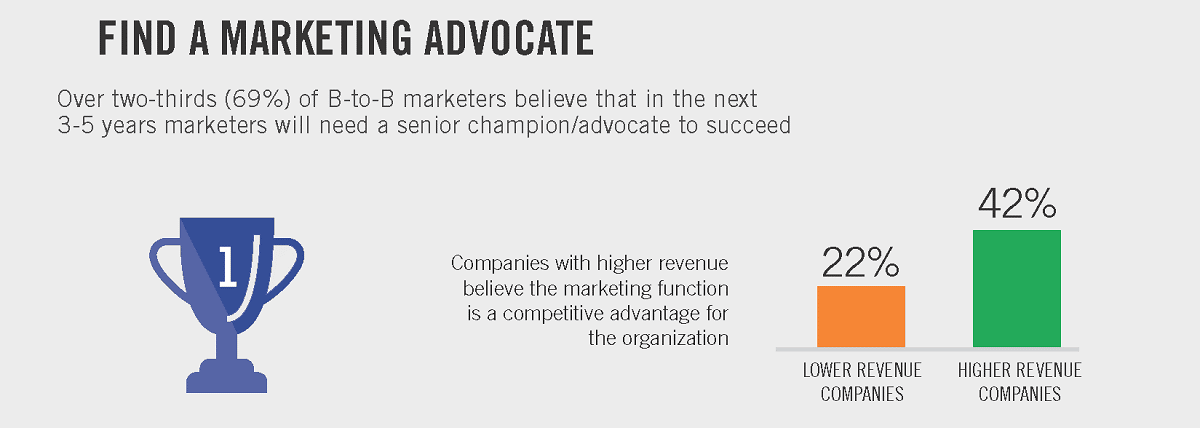
14. Develop and Invest in Marketing ROI Metrics
The ability to measure results and demonstrate that B2B marketing contributes to the company’s bottom line and enables business growth will help change the perception of marketing as a competitive advantage rather than cost center for organizations. But nearly 60% of B2B marketers say they do not have the appropriate measurement tools they need to effectively prove their ROI.
The top strategy for removing these barriers is to develop ROI metrics and invest in marketing strategies and technologies that will enable marketers to measure and demonstrate ROI.
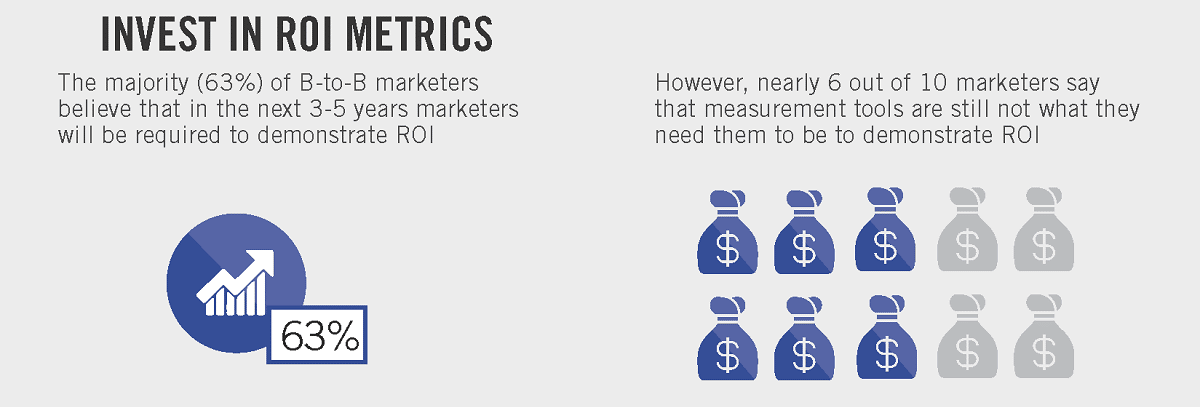
15. Build Relationships with IT and Finance
Higher revenue B2B companies believe cultivating close relationships with other organizations within the business, such as IT and Finance, is absolutely needed to successfully drive their marketing strategies, measure performance and manage marketing spend.

16. Create Content that Addresses Your Customer Journey
What differentiates high performing marketing organizations and marketers from their average peers is that they develop a deep understanding of their customers, including their biggest pain points and challenges, content needs and preferences, just to name a few.
Interestingly, many B2B companies don’t have buyer personas in place today, but do plan to build them in coming year to help boost the effectiveness of their demand gen efforts. A Demand Gen Report study found that only 27% of respondents said personas were aligned to their messaging and 30% noted that there will need to be some fine-tuning of their efforts.
Often, mistargeted or irrelevant content and messaging contributes to campaign failure. Detailed buyer personas offer a fantastic opportunity for marketers to ensure content is relevant for its intended audience, on the channels they prefer.
Using the customer insights gathered, successful B2B marketers develop specific marketing strategies for each buyer persona and create as well as curate content that is relevant and valuable to consumers at each stage of the customer journey, to effectively connect, engage and convert them.

17. Create a Brand Identity and Personality via Content
The B2B companies that achieve higher revenue focus their marketing efforts on developing and driving a consistent brand identity at every online and offline touchpoint, creating a seamless, positive experience across all parts of the organization a customer touches and interacts with.
This requires marketers to develop a strong brand positioning against their competition, track and identify segments for better targeting, and communicate their insights to sales teams so they can adjust and improve their strategies accordingly.
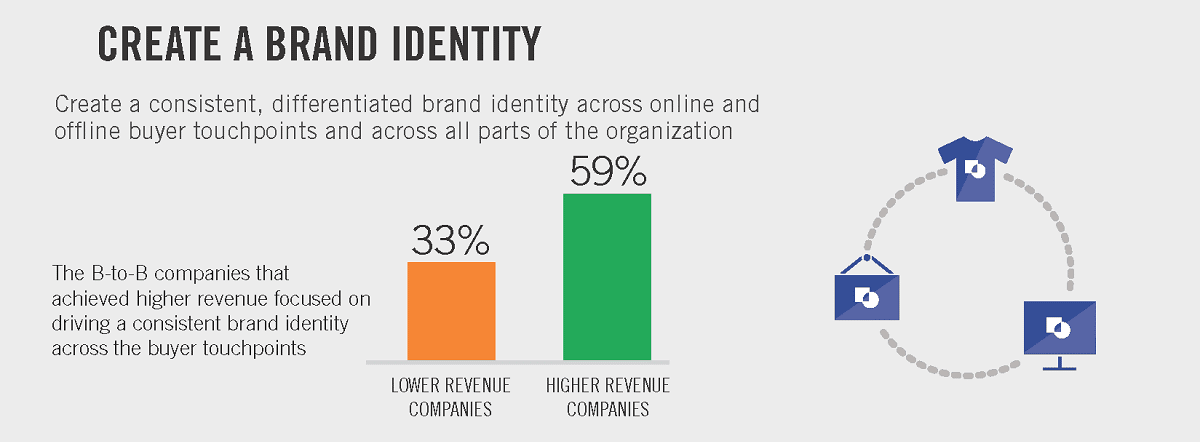
Very important question: Does your company have a clearly defined tone of voice, or does it vary from person to person in your PR or content marketing teams? Consistency is critical in any company’s communications, so you if you don’t have a tone of voice established, it should be a new priority that all employees can weigh in on. To get started, you can:
- Think about how you communicate successfully with existing clients
- Identify what type of tone you want to express to clients in the future
- Take a look at the competition and see how they’re communicating
Checking out your competitors is key here. You’ll likely want to communicate with your audience in a similar fashion, but you need to do it in a distinct way, which is where having a unique tone of voice comes in. It’s one of the most effective ways you can differentiate yourself.
The value of creating a distinct tone for your brand also extends to how you engage with your audience on social media. Also look to B2C brands to get a feel for how they interact with their audiences on social media platforms like Twitter. The digital divide between B2C and B2B is disappearing with every passing day.
Each company has a clearly distinct tone of voice and is unique in its own way. Then, think about how you want to interact with your audience on social media. Do you want the tone to match the rest of your communications, or do you want it to vary slightly because your audience on social may be different from your email subscribers or blog visitors?
18. Align and Build Ongoing Partnerships with Sales
Silos between sales and marketing organizations continues to be one of the biggest barriers to marketing success. And over half of all B2B marketers surveyed in a joint study by ANA and GfK believe better alignment between sales and marketing will help advance marketing’s contribution and ability to demonstrate their ROI.
The research found that the top three marketing objectives for B2B marketers are to generate sales and leads, improve brand awareness, and increase customer loyalty and retention, and it is crucial for marketing to partner and collaborate with sales in order to achieve these goals more effectively and drive business growth together.
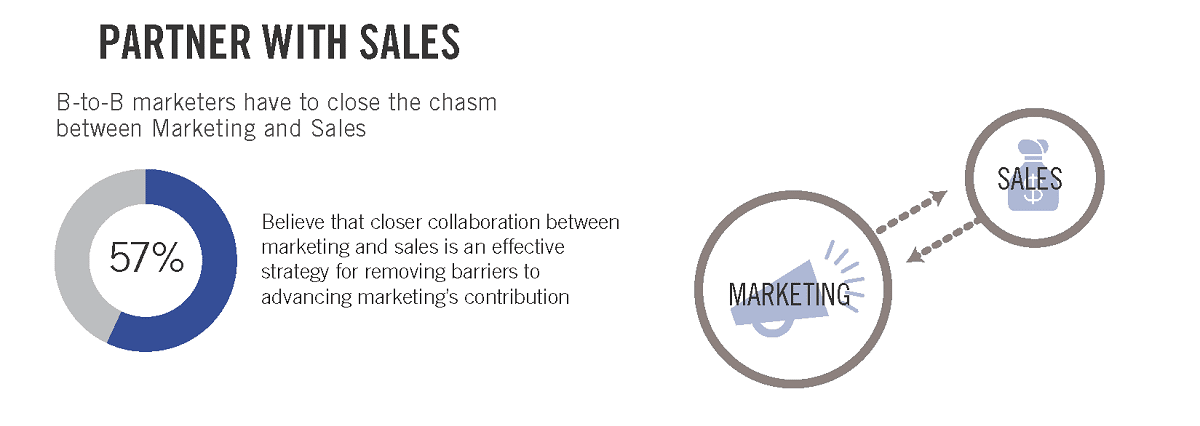
19. Acquire Digital Marketing and Technology Competencies
The wide adoption of digital and mobile by consumers will continue to accelerate, and B2B marketers believe this would require developing digital marketing and technology skillsets that most marketers currently do not have.
Only 7% of B2B marketers surveyed believe they have an effective process in place to capture data on customer behaviors, attitudes and engagement that can inform and optimize existing marketing strategies and tactics.

20. Create Interactive Marketing Campaigns
Over the past few years, marketing campaigns featuring interactive content have continued to increase in popularity. Why? Because anyone can write a blog post, and reading blog post after blog post can get, well, boring, and new types of content are always exciting.
Interactive content can be many different things—from quizzes, polls, and surveys to interactive infographics, whitepapers, and others. The goal of interactive content is simple: you want to get your audience engaged in the learning experience as opposed to simply reading an article or watching a video.
People—yes, even B2B professionals—like to participate in things. And interactive content provides a great opportunity for your audience to do exactly that. Content like quizzes, polls, and surveys also provides a unique benefit—it allows you to capture data from leads and learn more about your audience and what’s important to them. This data can then be used to inform future content marketing endeavors or guest blog posts—further allowing you to establish yourself as an industry expert and thought leader.
21. Focus on the Buyer
The buying process is becoming longer in the majority of cases, not shorter. This only underscores the need for B2B marketing organizations to move away from tactical one-and-done campaigns, to a strategic approach that maps content to this buying process and engages, nurtures and converts the buyer throughout their buying process.
What does this mean? It means that our B2B demand generation programs always have a sense of “what’s next” in terms of content. It means that marketers should not be promoting an asset, but seeking a conversation. This requires a buyer-centric strategy and without this in place, there is no way marketers will be successful in connecting through this ever-growing buying process.
For B2B marketers, the complexity and world in which we operate in a day-to-day basis will only continue to shift, change and grow with increasingly complexity. A tactical approach of spending, creating and pushing more of anything, is not the answer. There must be real transformation that enables us to get to know and engage our buyers at a deeper level and ultimately, meet them where they are in their process. It’s all about the buyer, so go figure!
22. Partner with B2B Influencers
The thing with B2B marketing is that it’s not really a bright and shiny object. It’s not as cool, fun or exciting as let’s say, working with Kim Kardashian or Jared Leto. Don’t expect to see any viral TikTok videos about data centers or enterprise software anytime soon.
But one thing that B2B brands can capitalize on is influence. And understanding influence has a much longer shelf life of value than a viral TikTok video.
Influence is more than just a noun or verb. Influence has the power to separate brand leaders from those who follow, especially when it is applied and becomes ground zero for all marketing.
Stemming from ground zero is B2B influencer marketing and programs like this can be managed in many ways. One of the most important steps in building an influencer program is research and analytics. Influencers just don’t appear overnight or wake up one morning with millions of followers. And even if they did, it wouldn’t mean that they’d be crowned an influencer.
Influencer marketing might not be for you and your brand at the current moment, but influential voices will always matter. And that spans across multiple marketing channels and campaigns.
- The influencer marketing industry reached almost $20B last year.
- 82% of people trust social networks social networks to guide purchasing decisions. [Source: DMI]
- 86% of women use social media for purchase advice.
- The return on social media marketing investments have surpassed those of print marketing, and that’s not changing any time soon.
An analysis must happen to identify truly influential voices. Part of that analysis will also uncover the topics and themes that influencers are talking about and how that content is spreading across the digital ecosystem.
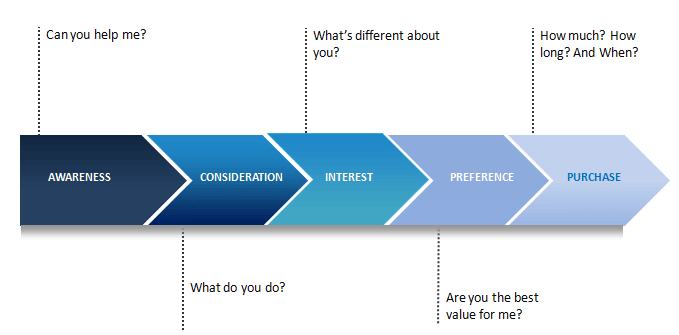
Take a look at this buyer journey graph above. At which point do you believe influential voices would play the strongest part: awareness, consideration, interest, or preference?
The answer is all of them. We can’t measure the precise back and forth behavior that each buyer experiences, but planting influencers around your messaging who can speak to your audience’s pain points could benefit you if there’s industry opportunity.
These types of insights can inform all content marketing. The result is brand relevance and search engine visibility. In this case, there is value from using B2B influencers, which could have an everlasting benefit. Some quick ideas:
- Reach out to some analysts for a trends or predictions piece
- Cover the top stories and trends in your industry and mention the influencers who are driving them
- Create a Top Influencers report in your industry report like we did with this one
- Work with a few influencers this year to co-create some content
- Attend influencers webinars and write articles about what they say
Using some of these (mostly free) tips to working with B2B influencers can really help to create some connections while borrowing on their fame.
23. Master the Art of “Trendjacking”
Many B2C companies are experts at jumping onto the latest trend or pop culture reference to get more attention to their marketing campaigns. Just look at the number of companies that produced campaigns themed around the hugely popular series, Game of Thrones. Ikea, Johnny Walker, and KFC all jumped on the GoT bandwagon, along with dozens of smaller brands.
It can be a little more difficult for B2B companies to use this tactic without coming over as cheesy and like they’re trying to hard, but it can be a very effective marketing tactic when done well.
One great example of successful B2B trendjacking is premium stock photography and video site Shutterstock. The company created their own promotional video for the ill-fated Fyre Festival using their own stock clips.
Not only did this video manage to attract a huge amount of attention due to the social media buzz and controversy around the festival, but it was also an incredibly effective way for the brand to showcase how stock footage can be used to create an impressive promotional video on a small budget. In just one day.
You don’t have to put a lot of time and resources into building a whole campaign around this tactic, either. This social media post by financial trading platform eToro joined the trending #10YearChallenge to draw more attention to its product and engage its audience.

24. Encourage Customer Advocacy
The formula is proven and it’s simple. It’s easier and cheaper to keep current customers happy than to acquire new ones. This is such a good marketing lesson yet so many brands don’t prioritize their current customer relationships. They are too focused on customer acquisition.
Building customer advocacy programs seem to be a thing of the past. But here’s the thing, it wasn’t always that way. In the early days of social media, building customer communities was common practice for all brands that had a Facebook page and Twitter account.
It was easier back then because the networks were much smaller back then, and organic reach on social media was 100%. Those were the good old days.
Customer advocacy needs to be both a mindset and a program. If it’s a mindset, then the whole company will build programs, campaigns, products and services, process, and general business practices with a customer-first mentality.
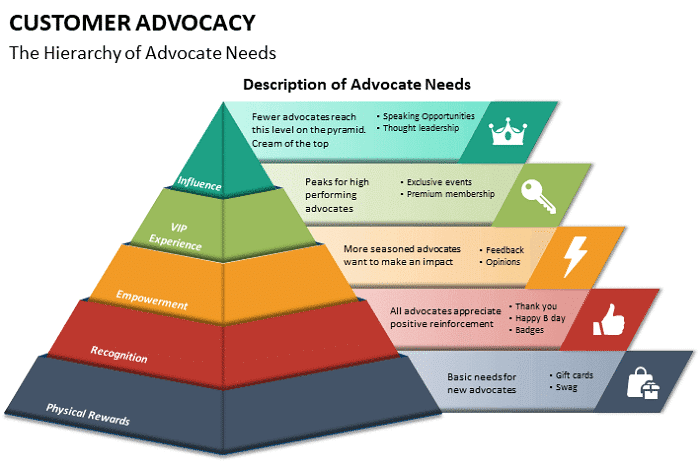
For example, if you infer from the customer journey map that responses to emails and requests for calls pop up 1-2 weeks after a purchase decision, you can begin anticipating your customers’ needs by giving them exactly what they want. But you’ll be beating them to the punch line.
Customer advocacy becomes a part of the cultural DNA. This will make building a customer advocacy program much easier to launch, manage and scale.
The key to building a program rests on the “all too familiar” people, process and technology. From this perspective, people represent the marketing teams responsible for managing the program.
Process is more about the mechanics of the program. It’s building a process on how the program will work, how it will be integrated into other marketing initiatives, how it will be measured and the overall strategic plan.
Technology is the tool or set of tools that will be used to manage the customer community and there are many available on the market.
25. Harness the Power of Storytelling and Emotions
B2C marketing tends to be rather emotionless and cold. This is because most B2B marketers follow the theory that B2B decision-makers buy with their head and not their heart.
While this is true to a point, it’s critical to remember that you’re still selling to a human, not a robot. As Forbes council member Joyce Salano puts it: “In reality, nobody is actually marketing to businesses — they are marketing to people. And people want content that is helpful and won’t put them to sleep.”
Of course, it’s still important to get across why buying your product or service makes good business sense. But, there’s no reason why you can’t follow the lead of successful B2C marketers and employ some storytelling tactics to make your messages more compelling and memorable.
Just take a look at this promotional video from management tool Airtable. It follows a group of children who are using the tool to help them plan and film a movie:
The video is not only cute, funny, and memorable, but it also effectively demonstrates how the software can be used in a number of different ways.
Compare it to their standard introduction video, which also demonstrates the product in a more traditional way. Both videos achieve the same purpose, but the first is more interesting to watch, and you’re much more likely to remember it.
If cute and playful isn’t appropriate for your brand, there are many other ways you can incorporate storytelling. Salesforce has an entire platform dedicated to its customer success stories, which demonstrates how companies in different industries and of varying sizes have used Salesforce to grow their business.
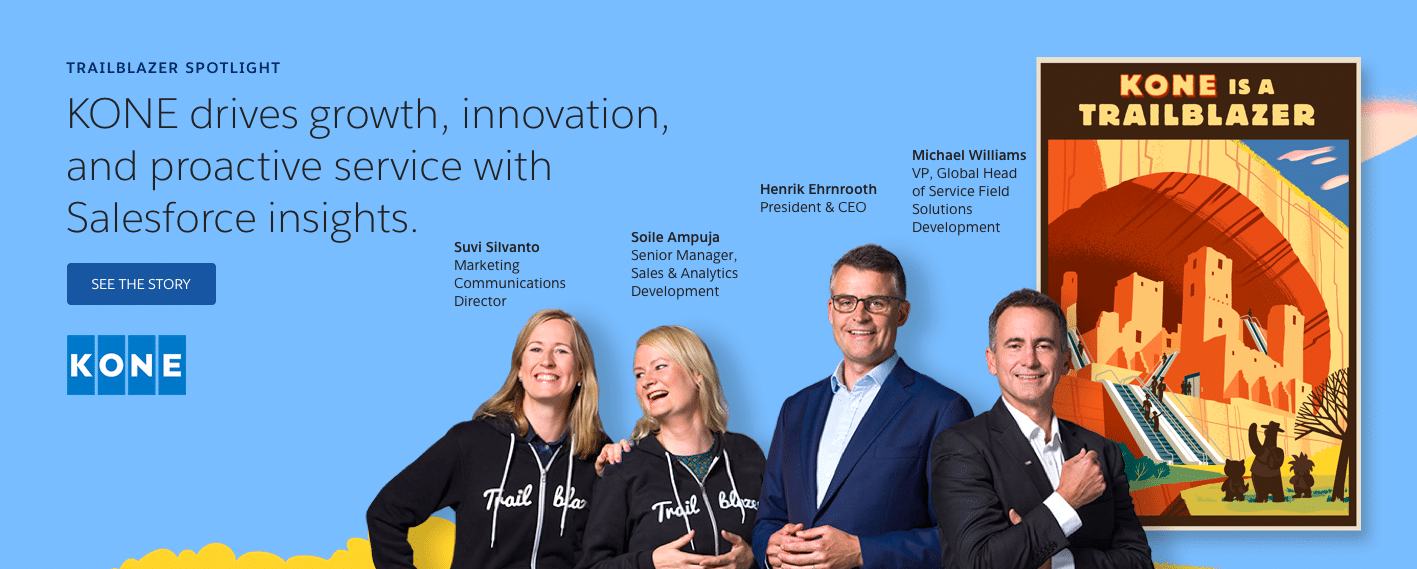
26. Turn Your Employees into Brand Storytellers
People trust people. It’s a significant part of our human nature. And that means that B2B buyers trust their peers, colleagues, influencers and “people like themselves” when seeking purchase recommendations.
Trust is the reason why people read Yelp reviews before booking a restaurant reservation or lookup the Amazon reviews before purchasing a pair of headphones.
Over the last decade, hundreds of studies and research reports have validated this point. So, when this trust paradigm is applied to B2B marketing, the opportunity to influence purchase behavior becomes real – very real.
This is one reason why building an employee advocacy program is a smart and strategic thing to do, especially for enterprise B2B and tech companies. And while many of these companies do have existing employee programs, there is a lack of innovation when it comes to deployment. They launched the program, checked the box and moved on.
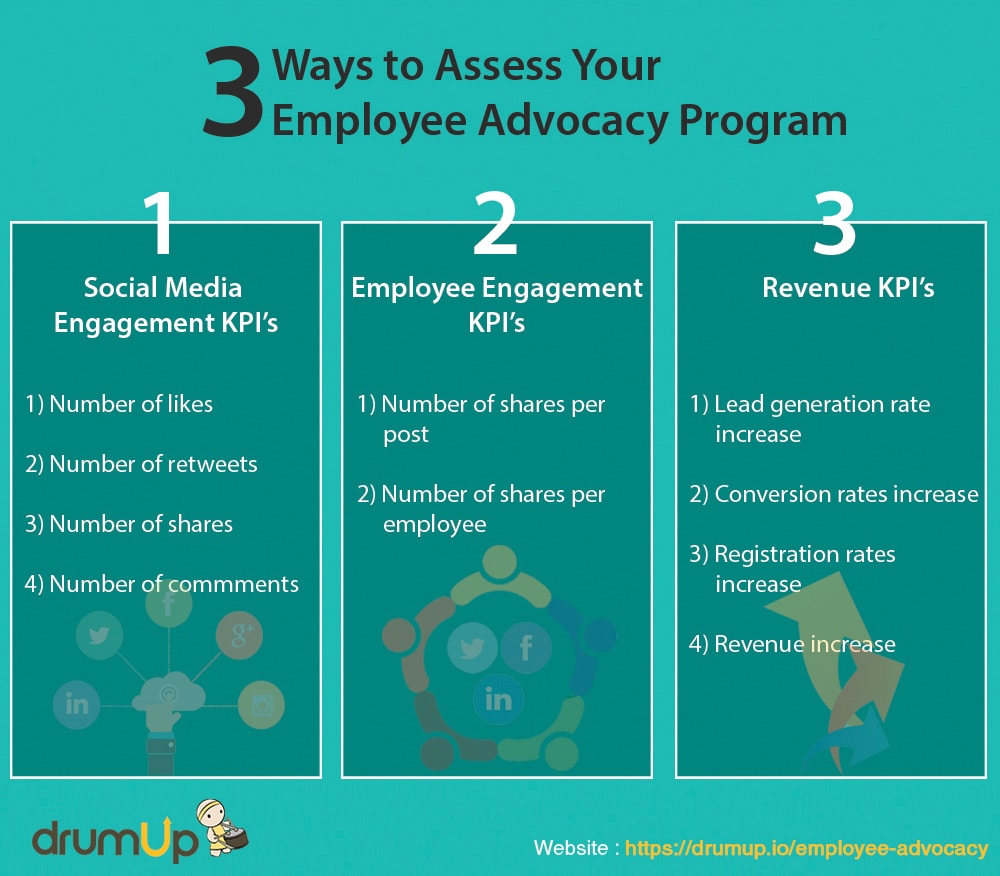
I like to call this Employee Activation because like customer advocacy programs, you need to find ways to get your staff to want to write and share.
27. Experiment, Be Creative, and Don’t Take Yourself Too Seriously
B2B marketing has a bad reputation. Marketing materials targeted at businesses are not exactly known for their innovative and exciting ideas. If you think about the first words that pop into your head when you think about B2B marketing, they’re probably “corporate,” “dull,” “old school,” and so on.
And, this isn’t working anymore. Research shows that B2B marketers are lagging behind their B2C peers in several areas, including technology use, analytics, and innovation.
Stop following the unwritten rule that B2B marketing has to be dull and dry. It’s true that B2B buyers must be more logical and less emotional than B2C buyers, but they’re still human – you can still appeal to their desire for humor and to be entertained.
B2B marketers have additional challenges, of course. B2B products tend to be much more complex and at a higher price point. B2B buying cycles are also much longer than B2C and involve many different stakeholders, compared to B2C purchases, which are often instantaneous and involve one person only.
It’s not simple or easy to overcome these challenges, but they don’t mean that your B2B marketing has to be safe, dull, and lacking personality, either. B2B marketers can follow the lead of B2C marketers to inject a little fun and innovation into their marketing strategy and put the spark back into their marketing.
The fact is that many B2B marketers have got themselves into a rut and fallen into the trap of thinking that marketing messages targeted at businesses need to follow a formulaic template. A lot of corporate marketing materials look the same – a color pallet of blue, white, and grey, with some standard stock photography of people in suits.
The world’s most successful brands don’t conform to the norms and are innovative with their marketing. There’s no reason why you can’t experiment, just because you’re marketing to a company rather than an individual.
Try using a bold color palette. Ditch the dull stock photos, and use some fun abstract images or illustrations. Be creative. Don’t be afraid to inject a bit of humor into your copy.
Many B2B brands are afraid of deviating from the corporate norm for fear that they won’t be taken seriously, but having the confidence to experiment and do something different and unexpected can make your business get noticed in a crowded market place.
To see how effective this approach can be, just take a look at the Euphoria campaign by Slack – rainbows and pink unicorns – not exactly your standard corporate imagery!

But, the campaign did its job at getting noticed and was a huge success. Instead of touting stats about productivity and efficiency in the usual dull and boring way, Slack created a campaign that was both educational and memorable.
How Will You Adapt Your Strategy This Year?
It’s easy for us to think that we need to reinvent our strategies at the start of a new quarter or fiscal year, but have you ever considered that the answers are right under your nose? Maybe you’ve even deployed a few strategies before, but when they didn’t deliver immediate results, you tossed them.
There are tons of marketing strategies, and we’ll be the first to admit that they are not all made equal. Consider taking a step back to reinforce these marketing strategies that may be a bit rusty, but could actually work for you if you’re willing to whip out the WD-40.
Another thing: all of the B2B marketing strategies we discussed here have one common denominator: people.
Influencers, customers and employees all have a voice. They all have audiences, albeit some smaller than others. And they all have influence.
Customer acquisition is important. Yes, 100%. Content is like gold. Creative messaging and storytelling are also important and play a crucial role in marketing communications. But without the human layer, it goes back to that same marketing that everyone on the planet ignores and calls spam.
What’s next is activation. Brands must prioritize each of these internal and external stakeholders and integrate them into existing marketing programs, campaigns, and initiatives.
If you are ready to get more traffic to your site with quality content that’s consistently published, check out our Content Builder Service. Set up a quick consultation, and I’ll send you a free PDF version of my books. Get started today and generate more traffic and leads for your business.






